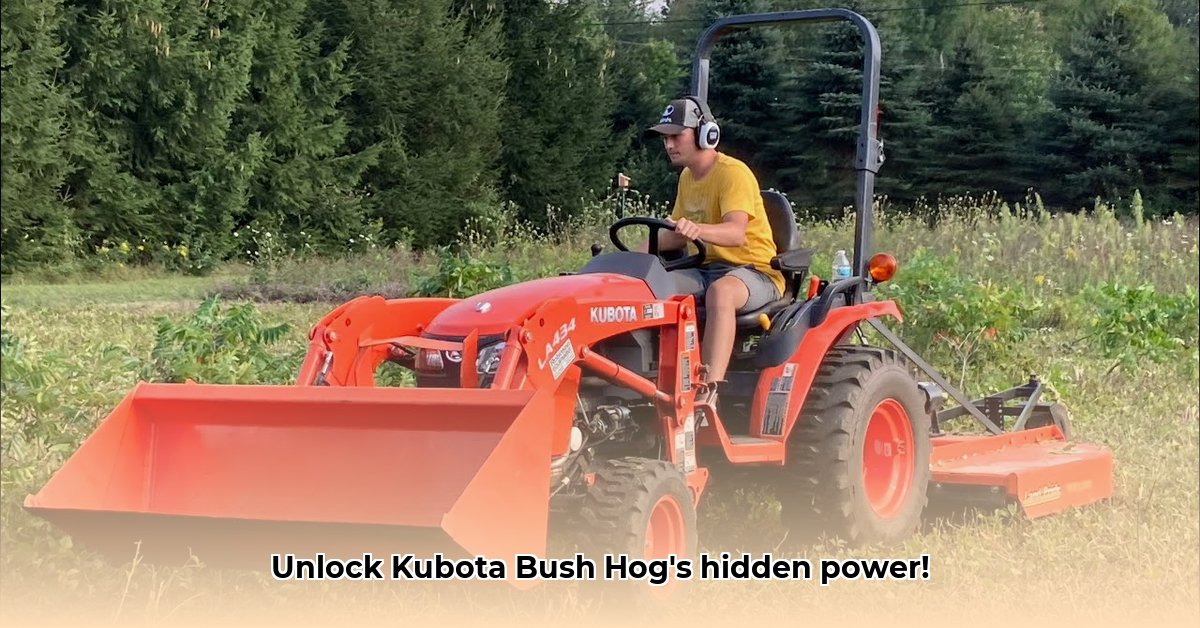
Kubota Tractor Bush Hogs: Optimizing Land Management for Sustainability
Kubota tractor bush hogs are essential tools for sustainable land management, offering efficient and environmentally conscious solutions for brush control and land clearing. This guide provides actionable insights for maximizing their performance and minimizing environmental impact, regardless of your farming experience level. Understanding your equipment and employing effective techniques are key to achieving both productivity and sustainability goals. Let's delve into the strategies that will transform your land management practices. For additional parts, check out Kubota parts.
Understanding Your Kubota Bush Hog: Pre-Operation Checks for Peak Performance
Before starting any operation, thorough preparation is crucial. This not only protects your investment but also ensures safety and optimal efficiency.
Blade Inspection: Regularly inspect blades for chips, cracks, or dullness. Dull blades reduce cutting efficiency, increasing fuel consumption and potentially damaging the machine. Sharp blades are essential for a clean cut and consistent performance.
Belt Tension: Correct belt tension is vital. Loose belts slip, leading to power loss and potential damage. Overly tight belts can also cause damage. Consult your owner's manual for proper tension specifications.
Fluid Level Checks: Maintaining proper levels of engine oil, transmission fluid, and hydraulic fluid is critical for preventing wear and tear. Consistent fluid levels ensure optimal performance and extend the lifespan of your Kubota bush hog.
Safety Systems Check: Always prioritize safety. Ensure all safety shields and interlocks are in place and functioning correctly before operation. Never compromise safety for speed or convenience.
Mastering Bush Hogging Techniques: Optimizing Cuts for Efficiency and Soil Health
Effective bush hogging requires more than just driving in circles. Precise techniques significantly impact both efficiency and environmental impact.
Consistent Overlap: Slight overlapping of each pass guarantees complete coverage and prevents missed areas. Think of it like painting—even, consistent coverage is crucial.
Ground Speed Optimization: Adjust your speed according to the terrain and vegetation density. Too fast leads to uneven cuts and potential damage; too slow wastes time and fuel. Find that "Goldilocks" zone for optimal performance.
Blade Height Adjustments: Adjust the blade height based on the type of vegetation and desired cut. Taller grass needs a higher setting than dense brush. Experimentation helps determine the optimal height for various conditions.
Terrain Awareness: Navigating uneven or rocky terrain requires reduced speed and caution. Protecting your equipment and preventing soil damage is paramount.
Fuel Efficiency and Sustainability: Minimizing Environmental Impact Through Practice
Fuel efficiency translates directly into cost savings and a reduced carbon footprint. Sustainable farming requires mindful operation and maintenance.
Regular Maintenance: Preventative maintenance is key to maximizing fuel efficiency. A well-maintained machine operates more efficiently, consuming less fuel.
Sharp Blades: Sharp blades reduce the engine's workload, leading to direct fuel savings. Dull blades require more power to cut effectively.
Minimize Idling: Avoid unnecessary idling. Start and stop efficiently to minimize wasted fuel.
Environmental Conditions: Soil moisture conditions can affect fuel consumption. Adjust your techniques accordingly for optimal efficiency. Did you know that dry soil conditions can often lead to a 5-10% increase in fuel consumption compared to moist conditions?
A Simple Maintenance Schedule for Long-Term Performance
Regular maintenance is vital for extending the lifespan and efficiency of your Kubota bush hog. This schedule acts as a guideline, always refer to your owner's manual for specifics.
| Task | Frequency |
|---|---|
| Blade Sharpening | Every 25-50 hours |
| Belt Inspection | Before each use |
| Fluid Level Checks | Before each use |
| Thorough Inspection | After each use |
| Major Service (grease, etc.) | Every 100-200 hours |
Dr. Anya Sharma, Agricultural Engineer at the University of California, Davis, emphasizes the importance of preventative maintenance: "Regular maintenance not only extends the life of your equipment but also contributes significantly to its long-term efficiency and reduces its environmental footprint."
Reducing the Environmental Impact: Sustainable Practices Beyond the Bush Hog
Sustainable farming is a holistic approach that extends beyond individual tools.
Precision Farming: GPS-guided tractors, coupled with data analytics, allows for precise operations, minimizing overlaps and fuel waste. "Precision farming techniques can lead to a 15-20% reduction in fuel consumption," states John Miller, a leading expert in sustainable farming practices.
Soil Conservation: Avoid excessive soil disturbance. Maintain healthy soil structure through practices like crop rotation and cover cropping.
Waste Management: Proper disposal of used oil and other waste materials is crucial for environmental protection.
Fuel Management: Implement strategies to monitor and reduce fuel consumption. Operator training on fuel-efficient techniques can yield considerable savings.
By implementing these strategies and prioritizing the principles of sustainable land management, you can significantly enhance the efficiency and longevity of your Kubota bush hog while minimizing your environmental impact. Remember, consistent maintenance, proper operating techniques, and mindful farming practices are the keys to success.